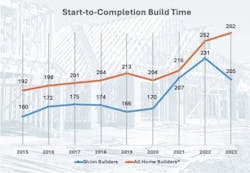Want to Shorten Your Build Time? It Is Possible
Earlier this year U.S. Census Bureau data showed an increase in the start-to-completion (build cycle) time for single-family homes from an average of 216 days (roughly seven months) in 2021 to 262 days (about 8½ months) in 2023, a 20% increase.
There was an expectation that when supply chains freed up and work returned to normal after the pandemic, the build time would return to pre-pandemic levels, but the Census numbers tell a different story.
This increasing delay in productivity is part of an overall decline in productivity across the full spectrum of the construction industry. A 2023 paper by University of Chicago economists Austan Goolsbee and Chad Syverson titled “The Strange and Awful Path of Productivity in the U.S. Construction Sector” points to a decades-long decline in construction productivity.
RELATED
- Cycle Time: the Gift That Keeps on Giving
- Managing With Data (or How to Get Your Processes to Talk to You)
- Is Off-Site Construction the Answer to Building Homes Faster?
5 Ways to Reduce Cycle Time
It doesn’t have to be this way—at least in residential construction. The home builders we work with at the Shinn Group tell a different story. Yes, their start-to-completion cycle times increased during the pandemic and continue to be longer than they were pre-pandemic, but to a lesser degree. And their cycle times have since fallen back to an average of 205 days, which is nearly two full months faster than the latest Census report data (see chart showing number of cycle-time days, below).
What are these builders doing that others aren’t? Simply, they are making a sincere effort to identify the issues driving build time, working with their trade partners on what can be improved, and analyzing their own processes.
Those efforts also line them up to be the “builder of choice” in the communities in which they build. The key to achieving that goal is managing cycle time. At Shinn, we emphasize specific cycle-time reduction principles, including:
- Avoid too many noncritical tasks on the schedule
- Focus on sufficient trade contractors and crew size
- Match production capacity with a proper schedule
- Employ the benefits of technology, such as master schedules and checklist apps
- Create continuous workflows by ensuring jobsites are ready for the next trade and every subsequent trade
With that, production scheduling should be centralized, and the duration of a task should be held to the actual time necessary to complete it.
Work expands to the time allotted, so scheduling buffers cannot be included in a task. Buffers should only be used at milestones in the build process (for example, framing) and used only as shock absorbers to keep the entire schedule on track. On the jobsite, superintendents are available when trades need them. Jobsites must be accessible all of the time during work hours and be clean and ready for the next trade.
We also work with trades to complete tasks within the contracted or scheduled time frame because having a trade return to complete a job or do rework extends build time and pushes the next trade back causing a ripple effect with damaging consequences.
Communication: the Key to Reducing Cycle Time
Underlying all of these principles and tools for reducing cycle time is communication.
Using scopes of work and making them available to superintendents and trade contractors provides structure for a job. In addition, giving access to current plans and making sure the production manager or the superintendent updates trades on changes to the schedule helps ensure the project can continue seamlessly.
RELATED
- 5 Steps to Circumvent the Labor Shortage and Be a Builder of Choice
- Project Manager Workloads: How Much Is Enough?
The Role of Leadership in Reducing Build Cycles
How do you get your home building operation focused on reducing cycle time? It starts with leadership, in all its forms.
Company owners and management need to lead their teams toward specific goals, provide the resources, and hold teams accountable. Superintendents, for example, must have strong management skills to work effectively with trade contractors to get homes built on schedule.
We train company owners, production managers, and superintendents in production management, including how to reduce cycle time. The training employs the same principles and methods across all of the positions and uses the same terminology. A production manager knows that the superintendents heard the same information and learned the same processes they learned.
When the company is aligned like that, it speeds communication across the organization and allows people to address issues as a team rather than dealing with them individually. The result: Cycle time is reduced and profitability increases.

